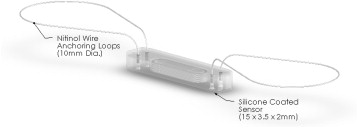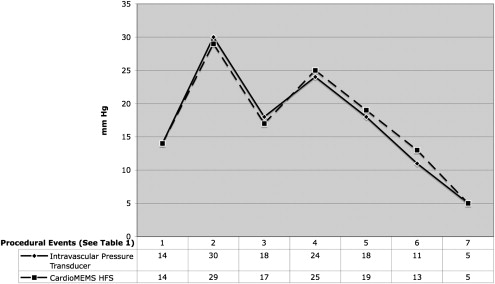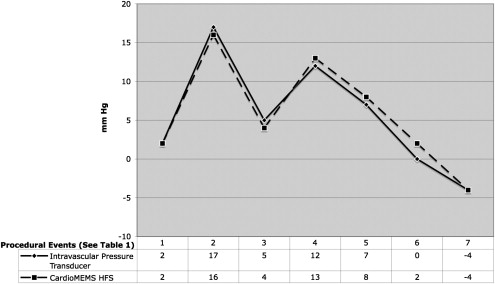Rationale and Objectives
Shunt surveillance is a critical component of follow-up for patients with cirrhosis with transjugular intrahepatic portosystemic shunts (TIPS). Transabdominal Doppler ultrasound analysis of the shunt has been used as a noninvasive means of assessing shunt function. Doppler ultrasound analysis of the shunt is less sensitive than direct transjugular portosystemic pressure gradient measurement for detecting shunt failure. A wireless, noninvasive means of measuring the portosystemic pressure gradient in the clinic may facilitate follow-up in this group of patients. The aim of this study was to determine if two implanted wireless pressure sensors could accurately transmit a portosystemic pressure gradient across a TIPS.
Materials and Methods
Two wireless microelectromechanical system pressure sensors were placed in a swine model for measuring the portosystemic pressure gradient across a TIPS. Catheter-based pressure transducers were also placed and used as the gold standard. Pressures from both systems were measured concurrently.
Results
Wireless microelectromechanical system portal and systemic pressure measurements were accurate within ±2 mm Hg (mean, 0.86 mm Hg) of the gold standard.
Conclusion
The use of wireless sensors may facilitate the surveillance of shunt function in patients with portal hypertension who have undergone placement of TIPS.
Transjugular intrahepatic portosystemic shunts (TIPS) have played a major role in the management of portal hypertension . Use of VIATORR covered stents (W. L. Gore & Associates, Inc, Flagstaff, AZ) has extended the 1-year primary patency rate of shunts to 84% . However, shunt surveillance remains a critical component of patient follow-up in preventing potentially fatal variceal bleeding. Contrast toxicity and radiation exposure preclude the regular use of transjugular pressure gradient measurement for assessing shunt function. The sensitivity of Doppler ultrasound for detecting shunt occlusion and stenosis is 96% and 94%, respectively . Body habitus and operator inexperience limit the usefulness of this modality.
Wireless microelectromechanical systems (MEMS) have been used to provide pressure data to surgeons during endovascular aortic aneurysm repair. A wireless MEMS sensor is deployed inside the aneurysm sac during exclusion of the aneurysm with an endograft. A reduction in intrasac pulse pressure ≥ 30% indicates that the aneurysm is successfully excluded. The Acute Pressure Measurement to Confirm Aneurysm Sac Exclusion (APEX) trial demonstrated agreement between the EndoSure MEMS sensor (CardioMEMS, Inc, Atlanta, GA) and angiography in detecting type I and III endoleaks in 92.1% ( n = 70), with sensitivity of 94% and specificity of 80% . The purpose of our study was to assess the accuracy of a wireless CardioMEMS device for measuring the portosystemic pressure gradient across a TIPS in a swine model. If proven useful, this sensor may make surveillance of TIPS shunts in the clinic possible.
Materials and methods
Get Radiology Tree app to read full this article<
Get Radiology Tree app to read full this article<
Get Radiology Tree app to read full this article<
Get Radiology Tree app to read full this article<
Get Radiology Tree app to read full this article<
Get Radiology Tree app to read full this article<
Table 1
Procedural Events
Event Description 1 TIPS created without balloon dilatation of tract 2 60 cm 3 of air injected into portal venous branches 3 Hourglass Wallgraft ∗ placed inside TIPS 4 13 cm 3 of air reinjected into portal vein 5 Dilated internal stent to 4 mm, air injected into portal venous branches 6 Dilated internal stent to 5 mm, air injected into portal venous branches 7 Dilated internal stent to 6 mm, air injected into portal venous branches
TIPS, transjugular intrahepatic portosystemic shunt.
Get Radiology Tree app to read full this article<
Get Radiology Tree app to read full this article<
Results
Get Radiology Tree app to read full this article<
Get Radiology Tree app to read full this article<
Discussion
Get Radiology Tree app to read full this article<
Get Radiology Tree app to read full this article<
Get Radiology Tree app to read full this article<
Get Radiology Tree app to read full this article<
Get Radiology Tree app to read full this article<
Get Radiology Tree app to read full this article<
References
1. Richter G., Palmaz J., Noldge G., et. al.: The transjugular intrahepatic portosystemic stent-shunt. A new nonsurgical percutaneous method. Radiologe 1989; 29: pp. 406-411.
2. Charon J., Alaeddin F., Pimpalwar S., et. al.: Results of a retrospective multicenter trial of the Viatorr expanded polytetrafluoroethylene-covered stent-graft for transjugular intrahepatic portosystemic shunt creation. J Vasc Interv Radiol 2004; 15: pp. 1219-1230.
3. Zizka J., Elias P., Krajina A., et. al.: Value of Doppler sonography in revealing transjugular intrahepatic portosystemic shunt malfunction: a 5 year experience in 216 patients. AJR Am J Roentgenol 2000; 175: pp. 141-148.
4. Ohki T., Ouriel K., Silveira P., et. al.: Initial results of wireless pressure sensing for endovascular aneurysm repair: the APEX trial—Acute Pressure Measurement to Confirm Aneurysm Sac Exclusion. J Vasc Surg 2007; 45: pp. 236-242.
5. Verdejo H., Castro P., Concepcion R., et. al.: Comparison of a radiofrequency-based wireless pressure sensor to Swan-Ganz catheter and echocardiography for ambulatory assessment of pulmonary artery pressure in heart failure. J Am Coll Cardiol 2007; 50: pp. 2375-2382.
6. Najafi N.: Initial animal studies of a wireless, batteryless, MEMS implant for cardiovascular applications. Biomed Microdev 2004; 6: pp. 61-65.


